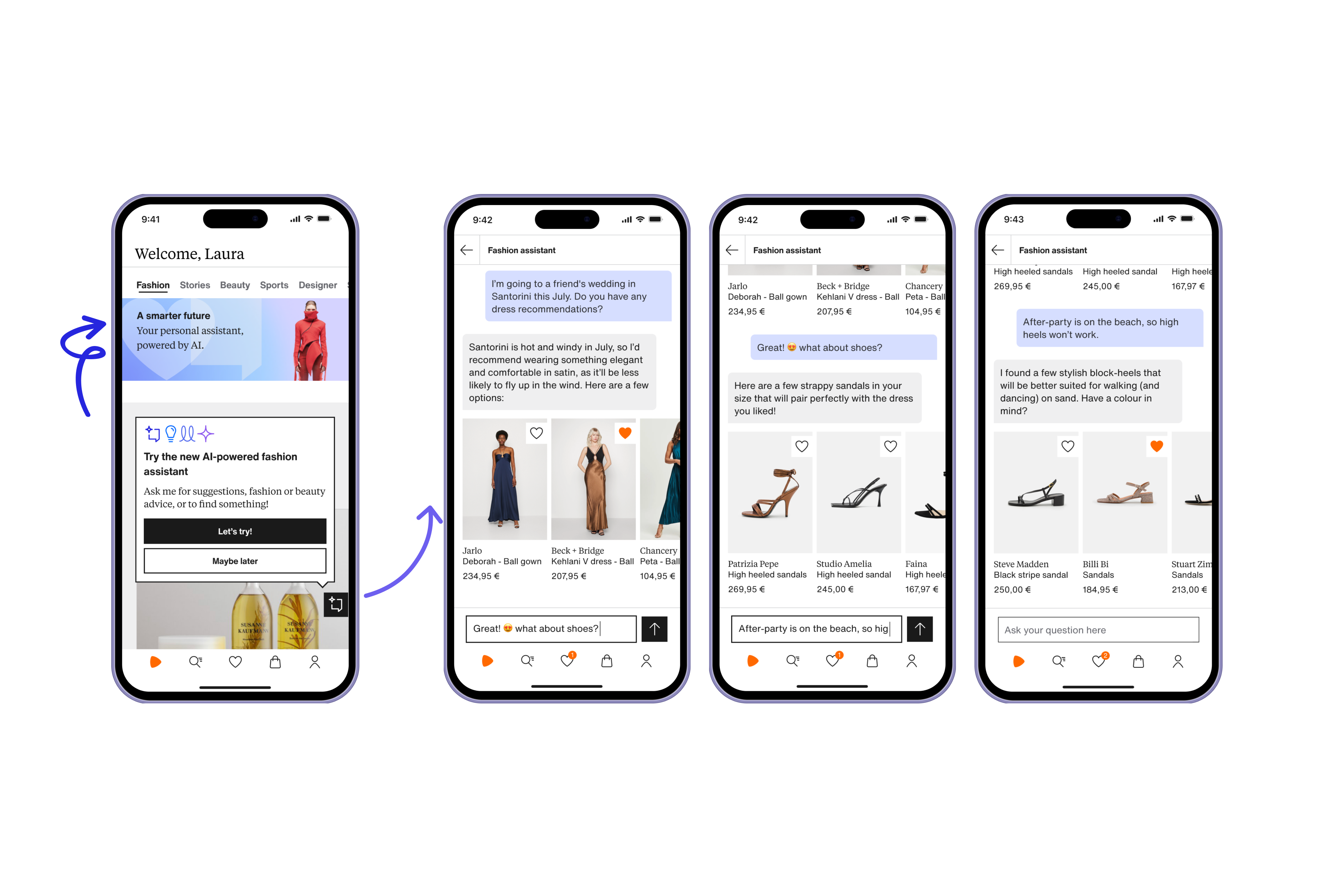


This week, a look at highlights from Shoptalk Europe, where the main topic of conversation was the adoption of AI and personalization strategies by major fashion retailers, and the trend of brands evolving into entertainment companies. The event, which concluded on Wednesday, was a hub of insights and innovations from industry leaders including Zalando, Amazon and H&M.
Shopping is about to get a more personal touch, as brands look at AI that curates your cart like it’s been snooping on your Pinterest boards.
Zalando has gone all in on AI to personalize its customer experience. The retail company sells over a million products from 6000 brands to around 50 million customers.
“We started prototyping conversational AI via a shopping assistant in April 2023, quickly progressing to a full rollout. It’s helping us provide hyper-personalized experiences,” said Tian Su, vp of personalization and recommendations at Zalando, during a Shoptalk Europe meeting. This approach has engaged half a million customers, who now spend three times as long interacting with the AI compared to traditional search, according to Su.
In May, the company launched TrendSpotter, which uses predictive AI based on Zalando shopping data to call out emerging micro trends in different areas of Europe, including Berlin, Paris, Milan, Antwerp, Stockholm and Copenhagen.
“We analyze early interest signals including search terms, wishlist additions and cart additions,” said Su. “These trends are not always popular or top sellers, but they provide crucial insights.”
Trendspotter sheds light on shifting customer interests, which benefits shoppers, as well as internal teams at Zalando and its brand partners. Trends like Barbiecore and hourglass blazers, influenced by cultural events, are called out by Trendspotter.
For its party, Amazon is using AI to consolidate reviews and develop search tools.
“We’ve been deploying AI technology for over 25 years, using it to forecast products demand, manage supply chains and enhance customer experiences,” said Ruth Díaz Barrigón, vp of Amazon Fashion Europe. “Rufus, our conversational AI shopping assistant, assists customers in finding products based on their queries and preferences.” The company launched Rufus in February.
Amazon Fashion Europe also uses generative AI to summarize customer reviews, to provide better size recommendations, and to improve search and discovery. These improvements have helped Amazon Fashion Europe reduce its return rates by 29%. Amazon had 1.5 million reviews from 150 million customers last year.
Finally, H&M is using AI to enhance its personalized experiences, but consolidating and prioritizing data has proven a challenge considering the breadth of data available to the company. “We need to unify our data lakes and ensure product attributes are well-categorized,” said Sylwia Wennberg, global head of external partnerships and collaborations at H&M. “This is a significant challenge but essential for our future.”
For the brand, personalization is largely about bringing the offline experience of customer service online. “We have a broad range of products and customers, so moving toward more of a conversation with the customer, using AI, is a future goal,” said Wennberg. “It’s about making the in-store shop assistant experience replicable and enhanceable with AI to make online interactions feel more personal and informed.”
Why fashion retailers are becoming entertainment companies
With its Trendspotter, which is meant to be accessed weekly, Zalando aims to carve out interactions with its customers that go beyond the product. On a similar note, H&M is upping its focus on sports and music partnerships. LVMH, meanwhile, is expanding its focus to films.
“[The focus on] entertainment is about engagement and connecting inspiration with realization. Creating inspiration tailored to the individual is where we see a lot of potential [for brands],” said Su. “We’re [targeting] daily engagement. We want Zalando to be top of mind for people, so when they want something, they think of us first.”
“Our future developments involve integrating entertainment components like music and arts to enhance customer connection,” said Wennberg. “We aim to go beyond traditional retail interactions and create a more holistic brand experience.”
Exclusive Research: How emerging technologies can address waste in fashion
According to a National Industry of Health report, the fashion industry produces approximately 92 million metric tons of textile waste each year, largely due to overproduction and ineffective inventory management, resulting in considerable environmental harm. A new report from consulting company Roland Berger claims that AI is a valuable tool in addressing the problem. Along with forecasting demand, it can play into software creating more detailed waste parameters for production.
“Approximately 30% of fashion garments are marked down at the end of the season, indicating an overproduction problem,” said Siobhán Géhin, senior partner at Roland Berger. “Reducing [that merchandise volume] by 4-5% could improve net profit by $30 million and reduce CO2 emissions by 2-8% for a $1 billion revenue fashion company, according to the report data.”
“Tech partnerships are key to reducing waste, but a significant challenge is that many factories serve multiple brands, reducing the incentive for brands to help factories become more efficient,” said Géhin. This is because brands that allocate more production typically get preferential treatment. “Regulation, like the European fast fashion legislation, will likely be a major driver in reducing this overproduction and promoting sustainability in the fashion industry.”
Executive shifts
Inside Glossy’s coverage
Other news to know